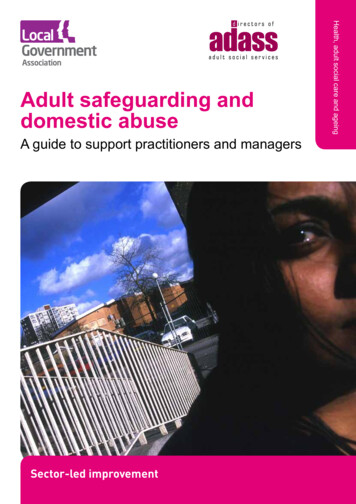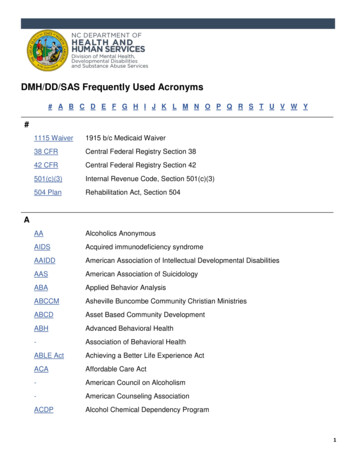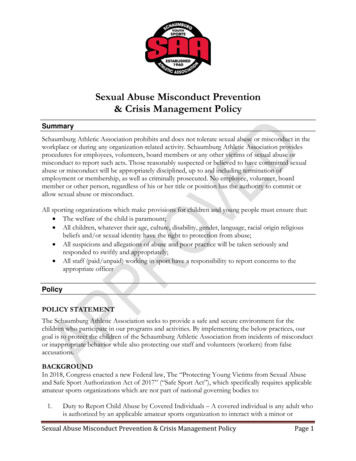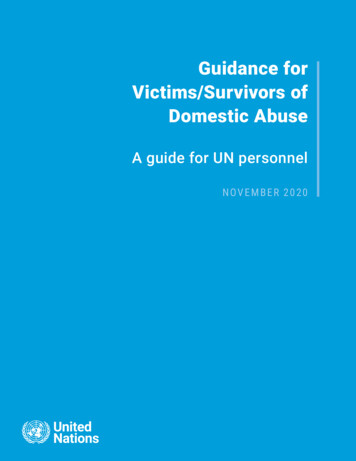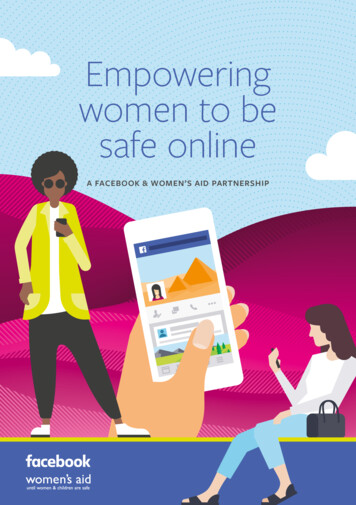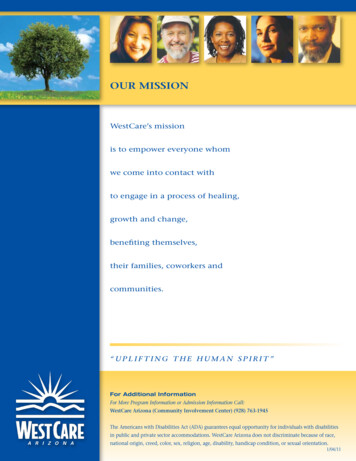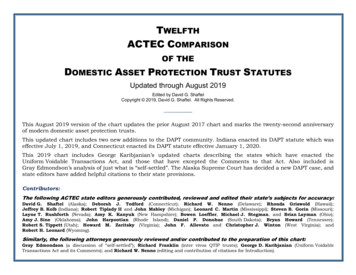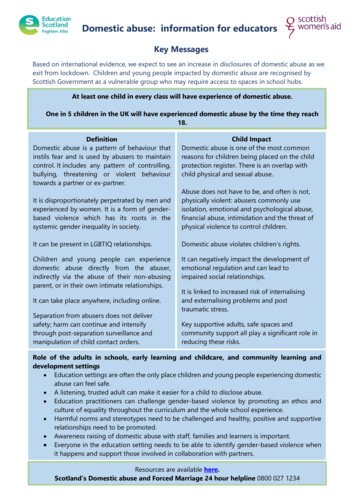
Transcription
Domestic abuse: information for educatorsKey MessagesBased on international evidence, we expect to see an increase in disclosures of domestic abuse as weexit from lockdown. Children and young people impacted by domestic abuse are recognised byScottish Government as a vulnerable group who may require access to spaces in school hubs.At least one child in every class will have experience of domestic abuse.One in 5 children in the UK will have experienced domestic abuse by the time they reach18.DefinitionDomestic abuse is a pattern of behaviour thatinstils fear and is used by abusers to maintaincontrol. It includes any pattern of controlling,bullying, threatening or violent behaviourtowards a partner or ex-partner.Child ImpactDomestic abuse is one of the most commonreasons for children being placed on the childprotection register. There is an overlap withchild physical and sexual abuse.It is disproportionately perpetrated by men andexperienced by women. It is a form of genderbased violence which has its roots in thesystemic gender inequality in society.Abuse does not have to be, and often is not,physically violent: abusers commonly useisolation, emotional and psychological abuse,financial abuse, intimidation and the threat ofphysical violence to control children.It can be present in LGBTIQ relationships.Domestic abuse violates children’s rights.Children and young people can experiencedomestic abuse directly from the abuser,indirectly via the abuse of their non-abusingparent, or in their own intimate relationships.It can negatively impact the development ofemotional regulation and can lead toimpaired social relationships.It can take place anywhere, including online.Separation from abusers does not deliversafety; harm can continue and intensifythrough post-separation surveillance andmanipulation of child contact orders.It is linked to increased risk of internalisingand externalising problems and posttraumatic stress.Key supportive adults, safe spaces andcommunity support all play a significant role inreducing these risks.Role of the adults in schools, early learning and childcare, and community learning anddevelopment settings Education settings are often the only place children and young people experiencing domesticabuse can feel safe. A listening, trusted adult can make it easier for a child to disclose abuse. Education practitioners can challenge gender-based violence by promoting an ethos andculture of equality throughout the curriculum and the whole school experience. Harmful norms and stereotypes need to be challenged and healthy, positive and supportiverelationships need to be promoted. Awareness raising of domestic abuse with staff, families and learners is important. Everyone in the education setting needs to be able to identify gender-based violence whenit happens and support those involved in collaboration with partners.Resources are available here.Scotland’s Domestic abuse and Forced Marriage 24 hour helpline 0800 027 1234
ContextAs a result of the COVID-19 lockdown measures, women, children and young peopleexperiencing domestic abuse are at increased levels of risk.1 Domestic abuse is apattern of behaviour that instils fear and is used by abusers to maintain control.Measures taken to address the pandemic, including lockdown, closure of schools,working from home and reductions in the work of courts, provide additional tools forabusers to exercise that control. This increases the risk to abused adults and children,removing opportunities for them to seek help and support both from their ownnetworks and from specialist services.For children and young people living with an abuser, lockdown and social distancingmeasures mean they are likely to have to spend prolonged periods of time at homewith their abuser, making it more difficult to engage with remote learning, callhelplines or find support from family or friends. Prior to lockdown, Women’s Aidgroups in Scotland were supporting around 350 children and young people per dayand a significant proportion of local Women’s Aid’s direct support for children andyoung people took place in school.For many children and young people experiencing domestic abuse, the school, earlylearning and childcare, or community learning and development setting, may be theonly place they feel safe. Even in a remote learning or blended learning context,teachers and other school staff such as homelink workers, or youth workers, can stillprovide lifelines to these children and young people. This information sheet outlinesthe nature of domestic abuse, the impact, indicators of children and young peopleexperiencing domestic abuse and how to respond to potential cases of domesticabuse.What is Domestic Abuse?The Domestic Abuse (Scotland) Act 20182 identifies domestic abuse as a pattern ofbehaviour that instils fear and is used by abusers to maintain control. It includes anypattern of controlling, bullying, threatening or violent behaviour towards a partner orex-partner including psychological and emotional abuse; this includes what iscommonly known as ‘coercive control’.Domestic abuse is disproportionately perpetrated by men and experiencedby women3. The UN identifies that domestic abuse, along with other forms of genderbased violence, is a form of gender discrimination and “one of the fundamental social,political and economic means by which the subordinate position of women withrespect to men and their stereotyped roles are perpetuated.”4Behaviours constituting domestic abuse can include: physical abuse, sexual abuse,isolating the survivor from family and friends, monitoring and regulating the survivor’sactivities, controlling their money and/or activities, depriving them from their freedomof action, frightening, humiliating or degrading them, among other things.52
PrevalenceThe police recorded 60,641 incidents of domestic abuse in Scotland in 2018-196. Weknow, however, that most cases of domestic abuse go unreported and the figures wehave do not reveal the true extent of the problem7. Where gender was recorded, fourout of five victims were women. One in 5 children in the UK will have experienceddomestic abuse by the time they reach 18 8. At least one child in every Primary 1classroom will have lived with the impact of domestic abuse their whole lives.9The experience of domestic abuse for children and young peopleDomestic abuse can profoundly disrupt a child’s environment, underminingtheir stability and damaging their physical, mental and emotional health10.Children who have lived with domestic abuse were previously describedas witnesses, but they are more accurately described as experiencing domesticabuse11. Whether or not the abuse is physical or emotional, in plain sight or behindclosed doors, children are extremely aware of and are impacted by the abusive actionsof the perpetrator. The actions of the abuser impacts family life in many ways.Violationofchildren’srightsFigure 1 Impact of abuseIsolation The abuser may prevent the children spending time with their non-abusiveparent, visiting friends and relatives, going on days out or participating in clubsor after-hours activities at school12. The isolation imposed on childrencan reduce their opportunities to build relationships with trusted adults outside thehome.3
Emotional abuse This can include name calling, demeaning or shaming comments. Itmight be pressurising the child to join in the abuse of the parent/caregiver or to keepfrightening secrets. The actions of the perpetrator can lead children and young peopleto live in a heightened state of fear and anxiety, walking on eggshells in case action orinaction triggers further abuse.Financial abuse This might mean that, even in a home with a reasonable income, theabused partner and child may experience poverty, for example being refused accessto funds to buy basic needs such as sanitary products or clothing. Money might beused to control behaviour.Multiple transitions Children and young people will often have to move home andschoolstoescapeabuse andtheremaybeseveralchanges ofaccommodation needed with all the related upheaval involved. As wellas interrupted learning, this can lead to loss of support networks and social isolation.Other abuse Children who experience domestic abuse are at higher risk ofexperiencing multiple forms of abuse13. There is an overlap between domestic abuseand child physical and sexual abuse. Domestic abuse is one of the most commonreasons for children being placed on the child protection register and was present inalmost two-thirds of significant case reviews in Scotland of children who have died.14Intimidation, coercion and threats Abusers can build fear through abusive acts orthreats of these towards their partner, other loved ones or a pet. It may be a ‘look’ thatwarns children that abuse is about to escalate. The abuser might threaten children withpunishment if they defend their parent or speak to others about what is happening athome.There is often an escalation of abuse when the abused parent tries to leave theirabuser, a period in which the abused partner and children are at heightened risk ofphysical violence and domestic homicide. Manipulation and abuse can continue to beexperienced through contact arrangements following parental separation.Children’s Rights Experiencing domestic abuse violates children’s rights15. There maybe rules imposed on when they can speak or act and they may be denied the right toplay, be involved in decisions affecting them and the right to live safe from violence.4
The impact of domestic abuse for children and young peopleChildren can be harmed by domestic abuse even when they are not witnessing orsubjected to direct abuse themselves. While it is thought that all children and youngpeople will be affected, the level of impact varies, even amongst those from the samefamily. Impact can depend on a range of factors such as the frequency, severity andlength of abuse and the ability of the non-abusive parent to provide parenting supportin these very difficult situations. Research suggests that serial witnessing of abuseand exposure to multiple types of abuse is particularly harmful.The impacts described below and in Appendix 1 are risks rather than the inevitablenature of harm. Key supportive adults, safe spaces and community support all play asignificant role in reducing these risks. Positive parenting by the non-abused parent(incredibly difficult when an abuser is undermining their partner) has been associatedwith decreased child trauma symptoms and increased child social competence andpositive youth development16. Many children and young people recover well whenthey are in a safe and secure environment.A wide range of effects on children have been identified17 including; feelings of fear,powerlessness, depression or sadness; impaired social relations; impact on the child’sidentity, educational achievement, extended family relationships and parentalrelationships and anger, very often displayed as aggressive behaviour.In terms of mental wellbeing18, experiencing domestic abuse as a child is associatedwith increased internalizing and externalizing difficulties, posttraumatic stress,difficulties in emotion regulation, and high separation distress. There are someindications of gendered differences with boys more external in their responses andgirls more likely to internalise their responses19 but evidence is mixed20.Children and young people’s physical health can also be impacted, for example, theyare at increased risk of obesity and asthma and often present with bodily complaintssuch as stomach aches.Appendix 121 illustrates impact by developmental stage. Impact can of course becumulative depending on the developmental impact on each stage of a child’s life.5
Signs of Domestic Abuse in school, early learning and childcare or communitylearning and development settingsThere are some common signs22 23to look out for in children that are potentialindicators of experience of domestic abuse. This is obviously more difficult duringremote learning but check-ins with learners or families may raise potential concerns.Figure 2 and 3 Signs of abuseIn terms of the parents or carers, you may see one partner speaking for the other, oneappearing more dominant and controlling of the other, regular calls to notify ofabsences, non-attendance at parents meetings and school events.Staff need to consider domestic abuse as one possible explanation for the signs listedabove but be aware that these could also signal other issues for the learner.Domestic abuse in teenage relationshipsIt is important to acknowledge that domestic abuse can and does occur in youngpeople’s own relationships. The term domestic abuse itself is unlikely to be one thatyoung people will identify with, even if it is happening to them, given the myths andstereotypes that continue to exist around it. The need for awareness raising andeducation is therefore more important than ever.Levels of abuse in teenage relationships are difficult to gauge and it is an area underresearched in the UK. Scottish Government figures for 2018-19 show that 6% of allreported cases of domestic abuse in Scotland involve young people under 18 yearseither as victims or accused.6
An NSPCC survey (2009)24 explored abuse in young people's relationships. They foundthat of those young people in relationships: 75% of girls and 50% of boys experienced emotional abuse of some form 25% of girls and 18% of boys experienced physical abuse 33% of girls and 16% of boys experienced sexual abuseThe picture for girls was particularly worrying with one in six reporting some form ofsevere abuse from a partner.In a Safe Lives study25of 183 victims aged under 18 years old that case workers weresupporting, two thirds were deemed to be ‘high risk’, that is, those deemed to be atrisk of serious harm or death.Abuse within teenage relationships can include all the areas discussed within adultabuse but might also include behaviours such as sexting, requesting or sharing ofimages, sharing of pornography, sexual coercion and grooming.The NSPCC reports highlights the importance of having discussions with young peopleabout relationships and abusive behaviour. Such behaviours are often considered‘normal’ within their relationships and offering a safe space to explore theirexperiences and the potential harms, supports young people to identify them asunacceptable and unhealthy. This further highlights the need for relationships andabuse to be included in the curriculum.The role of the adults in schools, early learning and childcare, and communitylearning and development settingsEducation settings have a unique opportunity, not only to identify and support childrenand young people who have experienced domestic abuse, but also to challenge someof the root causes, by promoting positive and healthy relationships and challenginggender inequality. Children and young people will have different needs when they areliving with domestic abuse and, later, when they recover from their experiences ofdomestic abuse. There will be variations in the levels of support required. Early supportis crucial, as this can help to mitigate the long-term impact of domestic abuse and helpimprove outcomes for children across education, development, health andrelationships.Supporting children and their families affected by domestic abuse requires; acurriculum and culture that promotes positive relationships and respect; staff who aretrained and aware (including non-teaching staff)26 and clear safeguarding policies andguidance. Strong partnerships with local specialist domestic abuse services, not onlyfacilitate professional learning opportunities, they can ensure joined up support forchildren and young people. Schools are in fact the main place where specialist7
domestic abuse services support learners. Contact details for specialist domestic abuseservices can be found in Appendix 2.Professional Learning Health and wellbeing is the responsibility of all. To properlyaddress domestic abuse, the professional development of all educators isfundamental. It not only helps practitioners to understand the dynamics of abusiverelationships, it helps them to identify families at risk and learn how best to supportthem and their education. Consider making contact with local Violence againstWomen partners for delivery of relevant and current professional learning.Safeguarding policies and guidance Local safeguarding protocols and proceduresshould always be followed, and particular care taken around the sharing of informationto ensure the perpetrator does not get access to details that could put the safety ofthe abused adult and their children at risk.Schools and other settings must prioritise the safety of the abused adult and childrenwhen taking any action regarding domestic abuse, including when communicatingwith them in regards to concerns. Perpetrators routinely intercept communications tothe abused adult and children and can use any suggestion of abuse to further isolateor justify harm to their victims. Safeguarding plans should reflect these considerations.Details of how to respond if a child or young person discloses domestic abuse arelisted on the next page.Supportive ethos Practitioners with a good understanding of the challenges facedby children and young people experiencing domestic abuse and the potential impactswill be better able to provide a supportive and empathetic environment. They will beaware that homework may not be completed because there are few quiet privatespaces in a refuge, that attendance may be poor because children are staying hometo protect family members or that there are gaps in learning from missing school ormoving to places of safety. Understanding and recognition of need can informplanning and support.Many abused children and young people will not be identified by staff. It is thereforecrucial that schools, early learning and childcare, and community learning anddevelopment settings offer nurturing, trauma informed responses to all their learners.Participation of children and young people The views of children and young peopleexperiencing domestic abuse are needed to help shape the decisions and planningrelated to their lives. They also have a valuable role to play in developing a wholeschool response to gender-based violence of which domestic abuse is onemanifestation.Awareness raising for learners In Curriculum for Excellence, learners are taught howto keep themselves safe and what to do when they don’t feel safe. As well as helpingthem to recognise any abuse in their own lives, young people often turn to their peersfor support, therefore understanding what a friend is going through and where to get8
help is important for all learners. Including this awareness raising in the curriculum,through Health and Wellbeing, Personal Social Education (PSE) or Relationships,Sexual Health and Parenting (RSHP) programmes, ensures co-ordinated and age andstage appropriate learning. Identifying peer support programmes and buddyingschemes can be helpful to provide structure and safeguarding around peer support.Responding to disclosures of domestic abuseIf a child talks to you about domestic abuse it's important, where possible, to speak tothe child in a safe, quiet and comfortable environment away from distractions andinterruptions1. They have likely chosen you because they trust you and feel safe tellingyou.It is important to follow your establishments safeguarding and child protectionprocedures. Listen carefully to what they are saying. Let them know they've done the right thing by telling you. Do not promise to keep it a secret. Stay calm but express your concern for them and convey that you are takingwhat they are saying seriously. Be kind, caring and friendly. Reflect to them what you are hearing them say, and the feelings beingexpressed. Do not ask ‘leading’ questions or become an investigator. Be non-judgemental and tell them it's not their fault. Do tell them they are not alone, that many women and children experiencedomestic abuse. Explain what you'll do next, ensuring the child’s views are sought on what is safefor them and their family. Follow your establishments safeguarding and child protection procedures assoon as possible. Reassure the child that there are places and people that can help. Let the child know that you will keep them informed at every stage about whatyou and your establishment are doing, in consultation with them about thesafest way to do this. Do not confront the alleged abuser. This could be dangerous for the nonabusive parent and children.Ensuing plans, including safety plans, following a child protection meeting mayinclude offering the child a space in a Hub if required.9
Equally Safe: Scotland’s strategyLonger term, schools, early learning and childcare, and community learning anddevelopment settings are ideally placed to address primary prevention and challengeinequalities and social norms that contribute to violence against women and children.In line with World Health Organisation policy27, Equally Safe (2016)28 is Scotland’sstrategy for the prevention and eradication of violence against women and girls. Itsets out priority areas for collaborative working towards a Scotland ‘where women andgirls live free from all forms of violence and abuse – and the attitudes that helpperpetuate them.’The 2017 Equally Safe delivery plan29set out several key priorities actions whereeducation settings can play a crucial role including: Raising awareness of gender-based violence and abuse Challenging gender stereotypes and norms Recognising and addressing unconscious bias and gender stereotyping Delivering relationships, sexual health and parenting and addressing safe andhealthy relationships and consent Developing a whole school approach to addressing gender-based violenceEqually Safe is supported by and links to several key education policies includingCurriculum for Excellence, Getting it Right for Every Child (GIRFEC) framework,Included, Engaged and Involved Part 2 and can be supported through a children’srights perspective.A whole school approach to ending gender based violenceThe whole school approach30 is one that promotes an ethos and culture of equalitythroughout the curriculum and the whole school. Not only will this help tackle theroots causes of gender-based violence but will also support a climate where youngpeople and families experiencing abuse are more likely to come forward and ask forhelp.Figure 4 Whole schoolapproach to endinggender-based violence10
A range of programmes and resources to support a whole setting approach are listedbelow.Recognising and realising children’s rightsRecognising and Realising Children's Rights inYouth WorkImproving Gender Balance 3-18Mentors in Violence PreventionRelationships, Sexual Health & ParentingEqually Safe at SchoolGender 10Key messages for Young Peopleon Healthy Relationships and ConsentHealth and wellbeing responsibility of all: makingthe links making it workHealth and wellbeing at the heart oftransitionsThese professional learning resource helpimprove practitioners' knowledge,understanding and application ofthe UNCRC in school and youth worksettings and support improvement.Resources challenging genderstereotypes, addressing unconscious bias,improving gender balance in subjectuptake and learner pathways andpromoting whole establishmentapproaches to equality are available here.Secondary school peer mentoringprogramme that gives young people thechance to explore and challenge theattitudes, beliefs and cultural norms thatunderpin gender-based violence.The national resourcefor relationships, sexualhealth and parenthood (RSHP) educationfor children and young people.Rape Crisis Scotland pilot of a wholeschool approach to preventing genderbased violence in schools in partnershipwith Zero Tolerance.Toolkit providing guidance and practicalexamples of how to use a whole schoolapproach to embed gender equality intoschool policy, ethos and the curriculum(primary school example).A resource for professionals which aims tohelp them support young people in theirunderstanding of healthy relationshipsand consent.This resource demonstrates howresponsibility for all can be enacted toensure the safety of children and youngpeople.This paper underlines the relationalapproaches at the heart of wellbeing aslearners transition to blended learning.Table 2 Education resources11
Signposting/resourcesA wakelet has been created to support our signposting/resources which has links tonumerous websites and videos which supports this briefing paper. It is easy to use andyou can quickly navigate to different sites from the one area.If you have experienced domestic abuse and would like information and supportplease visit this website or call Scotland’s Domestic abuse and Forced Marriage24 hour helpline 0800 027 1234.This briefing has been developed by Education Scotland in collaborationwith Scottish Women’s Aid.June 202012
-in-force/3 cotland-2018-2019-statistics/pages/11/4Committee on the Elimination of Discrimination against women (2017) General recommendation No. 35 ongender-based violence against women, updating general recommendation No. sticabuse-law/6 Scottish Government (2020) ‘Domestic abuse: statistics 2018-2019’7 Scottish Government and COSLA (2008) National Domestic Abuse Delivery Plan for Children and Young People8 Scottish Government and COSLA (2018) ‘Equally Safe: Scotland's strategy to eradicate violence against women’9 Save the Children (2006) ‘Safe Learning: How to support the educational needs of children and young peopleaffected by domestic violence’.10 Scottish Government (2014) ‘The National Guidance for Child Protection in Scotland’11 Victim’s Commissioner (2020) ‘Children’s experience of domestic abuse and criminality: A literature review’12 Katz, E (2016) Beyond the physical incident model: how children living with domestic violence are harmed by andresist regimes of coercive control. Child Abuse Review, 25(1), pp.46-5913 Jouriles, E. N., PhD., McDonald, R., PhD., Slep, A. M. S., PhD., Heyman, R. E., PhD., & Garrido, E., PhD. (2008). Childabuse in the context of domestic violence: Prevalence, explanations, and practice implications. Violence andVictims, 23(2), 221-35.14 SASW (2020) Domestic abuse and child welfare: a practice guide for social workers15 United Nations Convention on the Rights of the Child Ratified by the UK in 199116 Ehrensaft, M. K., Knous-Westfall, H., & Cohen, P. (2017). Long-term influence of intimate partner violence andparenting practices on offspring trauma symptoms. Psychology of Violence, 7(2), 296–305.17 McGee, Caroline. Childhood Experiences of Domestic Violence. Jessica Kingsley Publishers, 200018 Royal College of Psychiatrists (2017) Domestic violence and abuse – the impact on children and adolescents19 Wood, s. and Sommers, M. (2011) ‘Consequences of intimate partner violence on child witnesses: a systematicreview of the literature’ Journal of Child and Adolescent Psychiatric Nursing V.24,4, P. 223-23620 Artz, S et al. (2014) A comprehensive review of the literature on the impact of exposure to intimate partnerviolence for children and youth. International Journal of Child, Youth and Family Studies21 Howell, K., Barnesa, S., Miller, L., Graham-Bermannc, S. (2016) ‘Developmental Variations in the impact ofintimate partner violence exposure during childhood’J Inj Violence Res, 8 (1):43-5722 -of-abuse/domestic-abuse/23 people/24 NSPCC 2009 Barter et al, ‘Partner exploitation and violence in teenage intimate relationships’25 %20victims%20of%20domestic%20abuse.pdf26 Save the Children (2006) ‘Safe Learning: How to support the educational needs of children and young peopleaffected by domestic violence’.27 https://www.who.int/violence injury prevention/publications/violence/IPV-SV.pdf?ua 128 -womengirls/29 instwomen/30 ent/uploads/EVAW-Coalition-Schools-Guide.pdf1213
Appendix 1Impact by developmental stagePre-birth and infancy Most children (64%) who are exposed to domestic abuse will experience it from the first yearof life heightened risk of foetal death, prematurity and low birth weight Maternal distress in pregnancy can affect development of a secure attachment with child Maternal symptoms of trauma are also present in the infant By 24 months toddlers show evidence of cortisol dysregulation (cortisone is a stresshormone) Toddlers have twice the likelihood of asthma Increased likelihood of crying often, difficulty separating from caregiver and hard to soothe3-6 years Domestic abuse disrupts the development of self-regulation skills A dysregulated child may be aggressive to siblings/peers/authority figures Posttraumatic stress symptoms, for example nightmares or flashbacks, are present inupwards of 50% of children exposed to domestic abuse. Risk of heightened heart rate and cortisol response patterns Increased likelihood of early onset obesity and heightened risk for asthma Verbal ability and memory may be affected6-12 years Social relationships can be affected: difficulty developing and maintaining fri
For children and young people living with an abuser, lockdown and social distancing measures mean they are likely to have to spend prolonged periods of time at home . walking on eggshells in case action or inaction triggers further abuse. Financial abuse This migh
